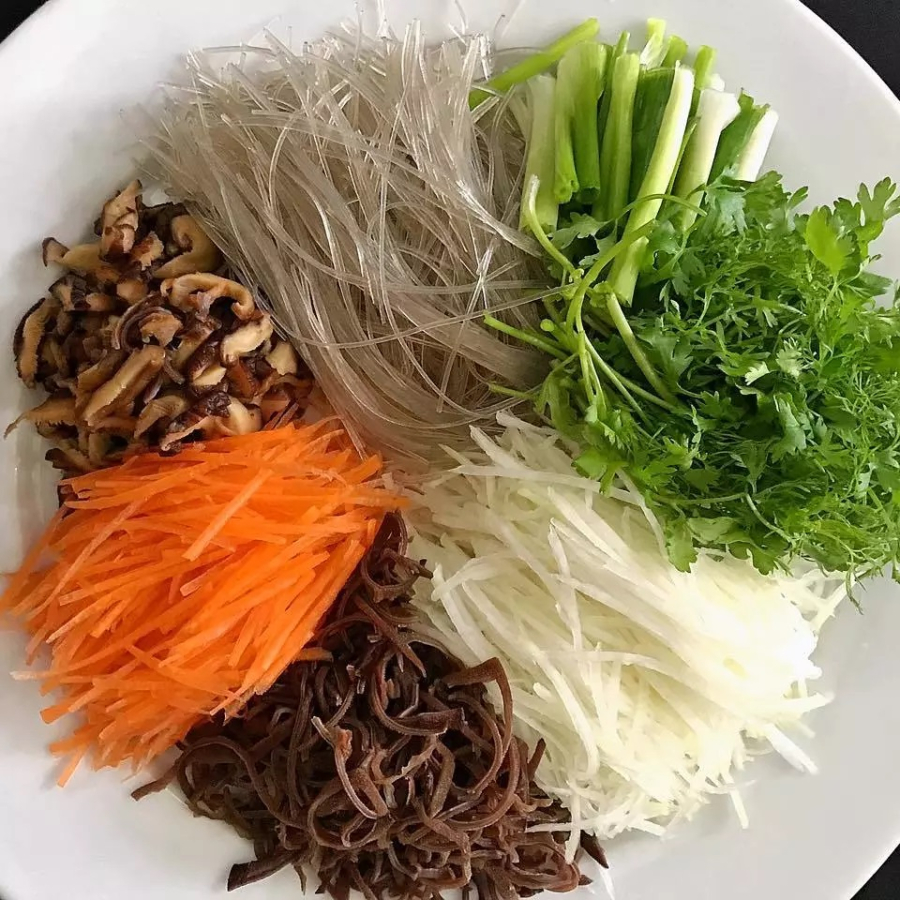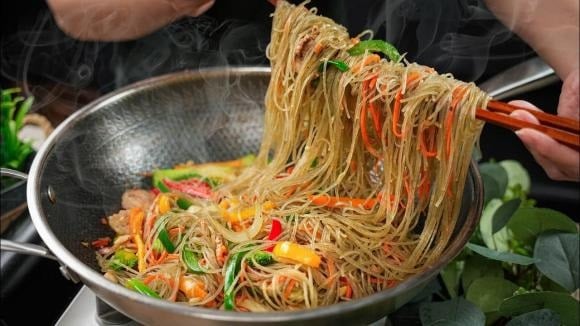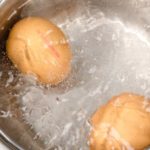Ingredients:
Glass noodles, ground pork, scallions, ginger, garlic, white vinegar, soy sauce, oyster sauce, black pepper.
In addition to the ingredients above, you can choose other foods according to your preference, such as eggs, cabbage, seafood…

Stir-fried Glass Noodles Ingredients
Common Types of Glass Noodles
There are many different types of glass noodles on the market in terms of ingredients, color, and cooking methods. For example, vermicelli is pale yellow in color and is dyed with molasses or other natural coloring agents. Vermicelli is light gray in color and is made from arrowroot starch.
Based on the ingredients, glass noodles can be classified as follows:
- Rice Vermicelli: 90% of the ingredients are rice starch, the vermicelli is opaque white.
- Arrowroot Vermicelli: Made from arrowroot starch (also known as banana or chock), the vermicelli is transparent and highly cohesive.
- Mung Bean Vermicelli: The main ingredient is mung bean.
- Mixed Vermicelli: The ingredients include various starches such as wheat flour, rice flour, arrowroot starch, mung bean, potato…
Instructions:
Take a sufficient amount of glass noodles and soak them in cold water for 5-10 minutes. Do not soak for too long as the noodles will become soft and mushy.
Bring a pot of water to a boil. When the water boils, drop the noodles in and boil for about 1-2 minutes, then remove them.
At this time, do not stir-fry the noodles immediately, but prepare a bowl of ice water, add some white vinegar, stir well, and drop the noodles in to soak. The hot noodles will meet the cold and the starches released during the blanching process will be cooled and contracted immediately, making the noodles more chewy and preventing them from sticking together when stir-frying.
Place a pan on the stove and add cooking oil. Add ginger and garlic and sauté until fragrant (you can substitute onion for ginger and garlic). Add ground pork and stir-fry until cooked, season with soy sauce and oyster sauce to taste (you can substitute soy sauce with fish sauce or salt depending on your preference).
When the meat is cooked, add the noodles and stir-fry. Toss a few times to loosen the noodles and combine them with the other ingredients.
If using other ingredients such as vegetables, remove the cooked meat and stir-fry the vegetables until cooked. Then add the meat and noodles and stir well. Season to taste.

Sprinkle with chopped scallions, herbs, and black pepper and enjoy immediately while still hot.
Tips for Stir-Frying Glass Noodles Without Sticking or Clumping:
One of the tips for stir-frying glass noodles without sticking is to add the noodles last, when the other ingredients have been cooked.
Separate the noodles into small bundles, cut into equal lengths, and fluff them into strands before cooking. This makes it easier to blanch the noodles, the noodles will be smooth and beautiful, and the noodles will not clump.
Soak the noodles in cold water for 5 – 10 minutes. Do not soak for too long, as it will make the noodles soft and mushy, prone to clumping and bland.
Blanch the noodles in boiling water: This step is very important and can even determine the success or failure of the dish. You have to work quickly, blanch the noodles for about 1 minute and then remove them immediately. This way, the noodles will not become soft and sticky when stir-frying.
Soak the noodles in cold water immediately after blanching (you can add a few ice cubes) so that the noodles do not stick together. When the noodles are cool, remove them and drain them. This will make the noodles more chewy and prevent them from sticking together when stir-frying.
Add a little cooking oil or egg white to the noodles so that it sticks to the surface of the noodles when stir-frying, preventing it from clumping.
Add the noodles last when the other ingredients have been cooked; stir lightly and evenly, then turn off the heat quickly.
Yes, glass noodles vary in ingredients, color, and cooking methods. Common types include rice vermicelli (opaque white), arrowroot vermicelli (transparent and highly cohesive), mung bean vermicelli, and mixed vermicelli made from various starches.
Soak the glass noodles in cold water for 5-10 minutes to soften them slightly. Then, boil them for just 1-2 minutes and immediately soak them in ice water with vinegar to cool and contract the starch, making the noodles chewier and less sticky.
- Add the noodles last, after all other ingredients are cooked.
- Separate the noodles into small bundles, cut to equal lengths, and fluff them before cooking.
- Soak the noodles in cold water for no more than 10 minutes to avoid sogginess.
- Blanch the noodles in boiling water for about a minute, then immediately soak them in cold water.
- Add a little cooking oil or egg white to the noodles before stir-frying to prevent clumping.
- Stir-fry lightly and evenly, then turn off the heat quickly once combined.
Absolutely! You can add or substitute ingredients according to your taste. For example, you can use fish sauce or salt instead of soy sauce, or include your favorite vegetables or seafood. Feel free to experiment and create your perfect stir-fried glass noodle dish.



































